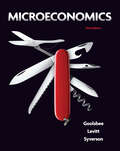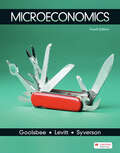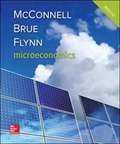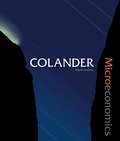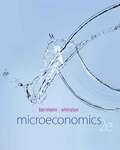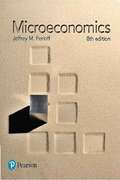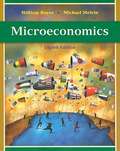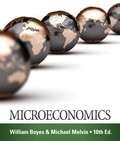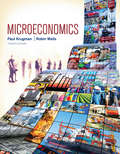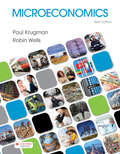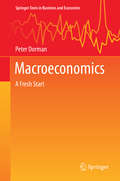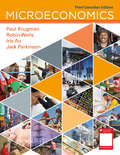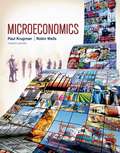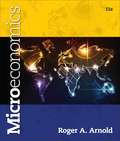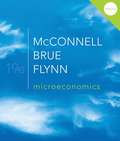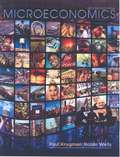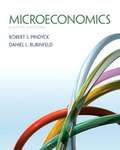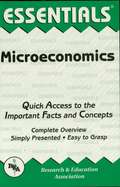- Table View
- List View
Microeconomics
by Chad Syverson Austan Goolsbee Steven LevittLike no other text for the intermediate microeconomics course, Goolsbee, Levitt, and Syverson’s Microeconomics bridges the gap between today’s theory and practice. A strong empirical dimension tests theory and successfully applies it. With carefully crafted features and vivid examples, Goolsbee, Levitt, and Syverson’s text helps answer two critical questions students ask, Do people and firms really act as theory suggests and How can someone use microeconomics in a practical way? The authors teach in economics departments and business schools and are active empirical microeconomics researchers. Their grounding in different areas of empirical research allows them to present the evidence developed in the last 20 years that has tested and refined the fundamental theories. Their teaching and professional experiences are reflected in an outstanding presentation of theories and applications.
Microeconomics
by Chad Syverson Austan Goolsbee Steven LevittGoolsbee, Levitt, and Syverson’s text helps answer two critical questions: Do people and firms really act as theory suggests and How can someone use microeconomics in a practical way?
Microeconomics
by Stanley L. Brue Sean Masaki Flynn Campbell R. McConnellMcConnell/Brue/Flynn has long set the standard for providing high-quality content to instructors and students alike. Known for versatility, comprehensiveness, and persistent innovation, it has remained one of the most trusted and reliable choices for principles of economics courses. The 21st edition continues to benefit from author Sean Flynn's influence with new discussions on strategic behavior, game theory, unconventional monetary policy and interest rate normalization. A robust set of content designed to facilitate classroom engagement through peer instruction has been developed to align with the learning objectives in the text. New innovations like interactive graphs and videos combine with SmartBook's adaptive reading experience and even more algorithmic and graphing assessment content in Connect to help students succeed in the course. McConnell/Brue/Flynn is expertly tailored to support a variety of course formats, institutions, and students. Its depth of content and breadth of resources continue to be unparalleled in the introductory market.
Microeconomics
by Daron Acemoglu John List David LaibsonThroughout Microeconomics, authors Daron Acemoglu, David Laibson, and John List use real economic questions and data to help students learn about the world around them. <P><P> Taking a fresh approach, the authors use the themes of optimization, equilibrium and empiricism to illustrate the power of simple economic ideas, and their ability to explain, predict, and improve what happens in the world. Each chapter begins with an empirical question that is later answered using data in the Evidence-Based Economics feature. As a result of the text’s practical emphasis, students will learn to apply economic principles to guide the decisions they make in their own lives.
Microeconomics
by David C. ColanderWritten in an informal colloquial style, this student-friendly Principles of Microeconomics textbook does not sacrifice intellectual depth in its quest for accessibility. The author's primary concern is to instill "economic sensibility" in the student. Colander emphasizes the intellectual and historical context to which the economic models are applied. Distinguishing features found within Colander's text are: Cutting Edge and Modern Colloquial Style Narrative Focus on Policy Emphasis on the Importance of Institutions and History Focus on Modeling: Economics is a method of reasoning, not truths. Presents Alternative Perspectives in Economics
Microeconomics
by David C. ColanderColanders Microeconomics 11e is specifically designed to help today’s students succeed in the principles of economics course and grasp economics concepts they can apply in their daily lives. Colander’s trademark colloquial approach focuses on modern economics, institutions, history, and modeling. Colander presents and applies economic models, but also encourages students to think about model nuances, building their critical thinking skills and applying models to the real world. <P><P> Content in Colander is organized around learning objectives to make it easier for students to understand the material and for instructors to build assignments within Connect. Through Connect and SmartBook, students will find engaging activities, helpful tutorial videos, and learning resources at that moment of need.
Microeconomics
by Douglas Bernheim Michael WhinstonBernheim and Whinston's Microeconomics 2nd edition is uniquely designed to appeal to a variety of student learning styles. The content focuses on core principles of the intermediate microeconomics course: individuals and firms making decisions, competitive markets, and market failures, and is delivered in a combination of print, digital, and mobile formats appropriate for today's learner. McGraw-Hill's adaptive learning component, LearnSmart, provides assignable modules that help students master core concepts in each chapter. Scan codes within the chapters give students mobile access to online resources including videos on how to solve In-Text Exercises. Extensive end-of-chapter material provides flexible options for both calculus and algebra-based courses. Bernheim and Whinston's completely integrated and accessible learning experience teaches students to apply and engage with a wide range of quantitative problems for more success in the intermediate microeconomics course.
Microeconomics
by Jeffrey PerloffFor all Intermediate Microeconomics courses at the undergraduate or graduate level. <p><p> A market-leading text, Microeconomics presents economic theory in the context of real, data-driven examples, and then develops your intuition through hallmark Solved Problems. The text places emphasis on modern theories--such as industrial organization theory, game theory, and transaction cost theory--that are useful in analyzing actual markets, while a step-by-step problem-based learning approach demonstrates how to use microeconomic theory to solve business problems and analyze policy. <p><p>The 8th Edition has been substantially updated with new or revised real-world examples, applications, and problems so that you gain a practical perspective, seeing how models connect to real-world decisions being made in today’s firms and policy debates.
Microeconomics
by William Boyes Michael MelvinEconomics is global and the Eighth Edition of MICROECONOMICS maintains the hallmarks of the Boyes/Melvin series--accessible writing, strong pedagogy, and integration of global economic issues--while faithfully presenting the latest thinking of economists on important microeconomic phenomena. The authors have carefully integrated their popular pedagogy, cutting-edge teaching and learning technology, and a full range of supplements to create a complete program that clearly illustrates the connections between key microeconomic principles and real-world business practices. The text has also been thoroughly updated with recent data and extensive coverage of important current issues, such as the economic effects of the war in Iraq, the 2008 financial crisis, and China's emergence as an economic power. In addition, MICROECONOMICS, Eighth Edition, provides an in-depth exploration of one of today's most significant issues--globalization--and its impact on economic growth and poverty, including a comparison of international standards of living and Global Business. A full range of accompanying learning technology ensures readers gain an understanding of the microeconomics concepts most important for career and business success.
Microeconomics
by William Boyes Michael MelvinGain a solid global understanding of microeconomic principles and examine the latest thinking on important microeconomic happenings with Boyes/Melvin's popular MICROECONOMICS, 10E. A reader-friendly writing style, carefully integrated learning features, and emphasis on global microeconomics help you fully understand the connections between key microeconomic principles and actual business practices. Timely revisions and the latest microeconomic statistics ensure you are learning about the latest microeconomic developments and their practical application to current events. New microeconomics coverage highlights current debate on government economic intervention and discussions of the Economic Freedom Index. You also gain an in-depth understanding of globalization and its impact on microeconomics today.
Microeconomics
by Michael ParkinGet students to think like economists using the latest policy and data while incorporating global issues. Microeconomics, 13th Edition builds on the foundation of the previous edition and retains a thorough and careful presentation of the principles of economics. The text emphasizes real-world applications, the development of critical-thinking skills, diagrams renowned for their pedagogy and clarity, and path-breaking technology. As a hallmark, features in the chapter openings and endings encourage students to think critically about a news article relating to the issue, demonstrating how thinking like an economist can bring a clearer perspective and deeper understanding of today’s events.
Microeconomics
by Paul Krugman Robin WellsWhen it comes drawing on enduring economic principles to explain current economic realities, there is no one readers trust more than Paul Krugman. With his bestselling introductory textbook (now in a new edition) the Nobel laureate and New York Times columnist is proving to be equally effective in the classroom, with more and more instructors in all types of schools using Krugman's signature storytelling style to help them introduce the fundamental principles of economics to all kinds of students.
Microeconomics
by Paul Krugman Robin WellsWith its signature storytelling style and coverage of current issues and events, Nobel laureate and New York Times columnist Paul Krugman and co-author, Robin Wells’s best-seller is the most effective textbook available for explaining how economic concepts play out in our world. This new edition offers incisive new insight into market power and externalities in microeconomics, updated analysis of long-run growth, and extensive coverage of the economic impacts and policy responses to the coronavirus pandemic in macroeconomics
Microeconomics
by Paul Krugman Robin WellsKrugman/Wells uses a storytelling style and current events to help you understand how economic concepts play out in our world.
Microeconomics
by Peter DormanFocused on Dhaka, and applicable to other cities, this book uses geospatial techniques to explore land use, climate variability, urban sprawl, population density modeling, flooding, water quality, urban growth modeling, infectious disease and quality of life.
Microeconomics (3rd Canadian Edition)
by Paul Krugman Robin Wells Iris Au Jack ParkinsonEngaging Students in the Study of Economics: We are committed to the belief that students learn best from a complete textbook program built around narratives, steeped in real life and current events, with a strong emphasis on global matters and with proven technology that supports student success. Narrative Approach: This is a textbook built around narratives and stories, many pulled from real life. In every chapter, stories are used to teach core concepts and motivate learning. We believe that the best way to introduce concepts and reinforce them is through memorable, real-world stories; students simply relate more easily to them. Global Focus: This book is unrivaled in the attention paid to global matters. We have thoroughly integrated an international perspective into the text, in the numerous applications, cases, and stories and, of course, in the data-based Global Comparison feature. Technology That Builds Success: Microeconomics is not just a textbook. It has evolved to become a complete program with interactive features designed and built to extend the goals of the text. This program encourages even stronger student engagement, mastery of the material, and success in the course.
Microeconomics (3rd edition)
by David A. Besanko Ronald R. BraeutigamBesanko and Braeutigam present the concepts and theory of microeconomics in a style that enables the reader to learn and experience it. The authors include numerous fully worked-out problems that provide a step-by-step road map to help them solve numerical problems. In addition, extensive real-world examples are integrated throughout the chapters that show contemporary applications of the theory. Each chapter also opens with an engaging example to draw readers into the material.
Microeconomics (4th Edition)
by Paul Krugman Robin WellsWhen it comes to explaining fundamental economic principles by drawing on current economic issues and events, there is no one more effective than Nobel laureate and New York Times columnist Paul Krugman and co-author, Robin Wells. In this best-selling introductory textbook, Krugman and Wells' signature storytelling style and uncanny eye for revealing examples help readers understand how economic concepts play out in our world. This new edition is revised and enhanced throughout, including a much stronger array of superior online tools that are part of a complete, integrated online learning system.
Microeconomics (Eleventh Edition)
by Roger A. ArnoldIn this edition, the author intends to provide a comprehensive coverage of the financial and economic crisis available in principles of economics text with new sections on the future of Social Security, Medicare and Medicaid, framing, and neuroeconomics.
Microeconomics (Fifth Edition)
by Paul Krugman Robin WellsPaul Krugman and Robin Wells’ signature storytelling style helps readers understand how economic concepts play out in our world. The new edition, revised and enhanced throughout, now offers holistic digital learning tools as part of SaplingPlus, a complete, integrated online learning system. <p><p> This new edition is revised and enhanced throughout, including a much stronger array of superior online tools that are part of a complete, integrated online learning system.
Microeconomics (Nineteenth Edition)
by Stanley L. Brue Campbell Mcconnell Sean Masaki FlynnMcConnell, Brue, and Flynn' s Economics: Principles, Problems, and Policies is the #1 Principles of Economics textbook in the world. It continues to be innovative while teaching students in a clear, unbiased way. The 19th Edition builds upon the tradition of leadership by sticking to 3 main goals: Help the beginning student master the principles essential for understanding the economizing problem, specific economic issues, and the policy alternatives; help the student understand and apply the economic perspective and reason accurately and objectively about economic matters; and promote a lasting student interest in economics and the economy. Connect is the only integrated learning system that empowers students by continuously adapting to deliver precisely what they need, when they need it, and how they need it, so that your class time is more engaging and effective.
Microeconomics (Sixth Edition)
by R. Glenn Hubbard Anthony Patrick O'BrienThe Relevance of Economics Through Real-world Business Examples <P><P>One of the challenges of teaching Principles of Microeconomics is fostering interest in concepts that may not seem applicable to students’ lives. Microeconomics with MyEconLab makes economics relevant by demonstrating how real businesses use economics to make decisions every day. And with an ever changing U.S. and world economy, the Sixth Edition has been updated with the latest developments using new real-world business and policy examples. Regardless of their future career path–opening an art studio, trading on Wall Street, or bartending at the local pub–students will benefit from understanding the economic forces behind their work.
Microeconomics 2nd Edition
by Paul Krugman Robin WellsThe product of the partnership of coauthors Krugman and Robin Wells, the book returns in a new edition. The new edition is informed and informative, solidly grounded in economic fundamentals yet focused on the realities of today's world and the lives of students. It maintains the signature Krugman/Wells story-driven approach while incorporating organizational changes, new content and features, and new media and supplements.
Microeconomics Eighth Edition
by Robert S. Pindyck Daniel L. RubinfeldA book that provides a treatment of microeconomic theory that stresses the relevance and application to managerial and public policy decision making.
Microeconomics Essentials
by The Editors of REAREA's Essentials provide quick and easy access to critical information in a variety of different fields, ranging from the most basic to the most advanced. As its name implies, these concise, comprehensive study guides summarize the essentials of the field covered. Essentials are helpful when preparing for exams, doing homework and will remain a lasting reference source for students, teachers, and professionals. Microeconomics includes the fundamentals of supply and demand, consumer theory, production, perfect competition, the monopoly, and factor prices.
